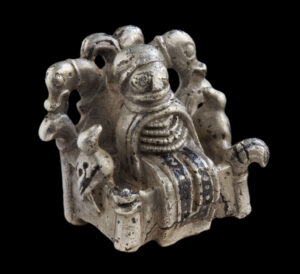The Norse relied on the natural world and various animals to explain creation and life during the Viking Age.
| “Westward drives the giant, Hrym, his shield high; the world-girding Serpent rises from the water, lashing at the waves; the bright-beaked eagle rends corpses, screaming; Naglfar sails free.” Völuspá, 37 |
The Völuspá, a Norse poem written in Iceland around 1000 CE that describes the history of the world and gods from the beginning to their anticipated end, includes a lot of imagery and references to animals. The poem includes discussion of themes from both the pagan and Christian religions present in Scandinavia at the time as the author was experiencing the fall of the Norse religion in Iceland and the conversion to Christianity. This poem is a part of the Poetic Edda, a collection of anonymous Norse poems. In the Völuspá, this line describes the giant serpent that circles the human world and continues to represent evil and the cycle of life and death, as well as the eagles that create winds with their wings felt in the human world. |
 Figure from Lejre, DK. |
This silver figurine from the Viking Age found in Lejre, Denmark is thought to be Odin, in female disguise, with his two attendant ravens, Hugin and Munin, on both armrests. These ravens are described to fly all over the world return at night to share with Odin everything they saw and heard. |
| “The holiness of a place does not help evildoers, but integrity of religion will make doers of good worthy of divine protection. Who is not afraid of the terrible fate that has come upon the church of St. Cuthbert? So mend your ways, lest the righteous perish for the sins of the wicked, lest the vineyard of the Lord be given up to be devoured by foxes, lest the feet of the pagans tread upon the sanctuary of God.”
Alcuin, Letter 29 |
Alcuin, a scholar and monk from York, wrote letters to the monastery in Lindisfarne after they were raided by the Norse and some of the monks fled, reassuring that those who stayed will be worthy of divine protection. Here, he describes the Viking raids on churches and their acts of violence as similar to foxes trampling the Lord’s vineyard, using these wild animals as a negative symbolism of the Norse’s barbarism and lack of humanity. |
 Vane from Heggen, NO. |
This is a gilt-bronze vane from Heggen church in Norway from the Viking Age with a Ringerike-style ornament engraved of a bird struggling with a snake, framed by tendrils. This is very similar to the animals described in the Völuspá with the serpent and birds and again reiterates the theme of Viking Age world building through animal imagery. |
| “The wolf stretched its jaw enormously and reacted violently and tried to bite them. They trust into its mouth a certain sword; the hilt touches its lower gums and the point its upper ones. This is its gum-prop. It howls horribly and saliva runs from its mouth. This forms the river called Hope. There it will lie until Ragnarok.”
Gylfaginning, 34 |
Gylfaginning is the first part of the Prose Edda written in 1220 CE focused on the creation and destruction of the Norse world, similar to the Völuspá. The Prose Edda and its detailed depiction of Norse mythology is thought to have been mostly recorded or written by Snorri Sturluson in Iceland. This quote describes the origin of a river from a wolf’s saliva. |
Alcuin. “The Raids of the Northmen.” In Alcuin of York, c. A.D. 732 to 804 – His Life and Letters, translated by Stephen Allott, 36–41. York: William Sessions, 1974.
Christensen, Tom. “A Silver Figurine from Lejre.” Danish Journal of Archaeology 2, no. 1 (2013): 65–78. (online)
Graham-Campbell, James. Viking Art. 3rd ed. London: Thames and Hudson, 2021.
Sturluson, Snorri. “Gylfaginning.” [The Tricking of Gylfi] In Edda, translated by Anthony Faulkes, 7–54. London: J. M. Dent, 1995.
Terry, Patricia, trans. “Völuspá.” In Poems of the Elder Edda, 2nd ed., 1–10. Philadelphia: University of Pennsylvania Press, 1990.
« Previous | Home | Next »